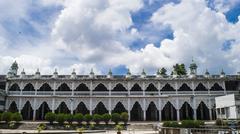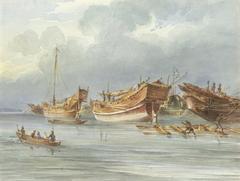Chittagong Buddhist Monastery: Visiting Hours, Tickets, and Comprehensive Travel Guide
Date: 14/06/2025
Introduction
The Chittagong Buddhist Monastery, also known as Nandan Kanan or Chattogram Bouddha Bihar, is a vital spiritual and cultural landmark in southeastern Bangladesh. With a history tracing back over two millennia, it stands as a testament to the region’s deep-rooted Buddhist traditions. The monastery is not only a place of worship, but also a center for education, community engagement, and cultural preservation, serving the local Bengali-speaking Buddhist community as well as indigenous groups such as the Barua and Chakma peoples. This guide provides detailed insights into the monastery’s history, architectural features, religious practices, visitor logistics, and tips for a meaningful, respectful visit.
For more background, see Buddhistdoor, Remote Lands, and local tourism resources.
Table of Contents
- Historical Significance and Evolution
- Key Figures and Rediscovery
- Architectural Features and Artistic Heritage
- Religious Practices and Festivals
- Visiting Information (Hours, Tickets, Accessibility)
- Community Role and Social Engagement
- Sustainable Tourism and Preservation
- Practical Tips for Visitors
- Nearby Attractions
- Frequently Asked Questions (FAQ)
- Visual Gallery
- Additional Resources and Sources
Historical Significance and Evolution
Chittagong’s Buddhist heritage extends over 2,000 years, with the region once being a prominent hub for Buddhist scholarship and religious practice. The area flourished during the Mauryan period (c. 269–232 BCE), with Emperor Ashoka initiating the construction of monasteries and stupas, such as the Rangkut Banasram Bihar, which preserved sacred Buddha relics (Buddhistdoor).
Despite periods of decline after the 11th century, the Buddhist community persisted, and significant restoration efforts in the late 19th and early 20th centuries helped revive these traditions. The modern Chittagong Buddhist Monastery is built on a foundation of this resilient heritage, blending ancient wisdom with contemporary relevance.
Key Figures and Rediscovery
Key to the monastery’s revival was Śrīmat Jagat Chandra Mahāsthabir (1850–1948), who played a leading role in archaeological rediscovery and restoration of Buddhist sites in Chittagong. His efforts, alongside those of other monks and community leaders, led to the uncovering of important relics and manuscripts, affirming historical connections with neighboring Buddhist regions such as Myanmar’s Arakan. Notable discoveries include a broken Buddha statue and Burmese stone inscriptions, which highlight the area’s longstanding links to the broader Buddhist world (Buddhistdoor).
Architectural Features and Artistic Heritage
The monastery’s architecture reflects a harmonious fusion of traditional South Asian Buddhist design and local Bengali influences:
- Main Shrine Hall: Adorned with Buddha statues, intricate murals, and woodwork that narrate the Buddha’s life.
- Stupa-Inspired Rooflines: Symbolizing enlightenment and peace.
- Library & Museum (Cintamani): Houses rare manuscripts, Burmese inscriptions, and historical artifacts (Buddhism in Bangladesh PDF).
- Residential Quarters: Providing accommodation for monks and novices.
- Community Halls: Venue for teachings, meditation, and social gatherings.
- Gardens and Courtyards: Offer tranquil spaces for reflection and meditation.
Notably, the monastery preserves the sacred hair relic of Gautama Buddha, displayed annually during a major festival (Remote Lands).
Religious Practices and Festivals
The monastery follows Theravada Buddhist traditions, with daily rituals including chanting, meditation, and alms rounds. Major festivals are celebrated with great enthusiasm:
- Buddha Purnima (Vesak): Marks Buddha’s birth, enlightenment, and passing with prayers, processions, and cultural performances.
- Kathin Chibor Dan: A robe-offering ceremony after the rains retreat.
- Annual Hair Relic Display: Draws thousands of pilgrims (Remote Lands).
- Community Service: The monastery serves free meals daily to over 300 people, regardless of faith, and hosts iftar during Ramadan to promote interfaith harmony (Facts and Details).
Devotees commonly offer flowers, candles, incense, and food, and create symbolic “money trees” during festivals.
Visiting Information
Hours and Tickets
- Visiting Hours: 8:00 AM – 6:00 PM daily (some references note 7:00 AM – 7:00 PM; verify ahead, especially during festivals).
- Entry Fee: Free; donations appreciated.
- Sacred Relic Display: Once annually during a special festival.
Accessibility
- The monastery is wheelchair accessible in most areas, with ramps and paved paths.
- Assistance available upon request.
- Some upper levels may have limited access.
Location and Getting There
- Centrally located in the Nandan Kanan area, near Cheragi Pahar and the Central Railway Building (Mapcarta).
- Easily accessed via local buses, taxis, rickshaws, and ride-sharing services.
- Approximately 15 km from Shah Amanat International Airport and 5 km from Chittagong Railway Station.
Facilities
- Main Prayer Hall and Smaller Temples: Open for visitors and devotees.
- Restrooms: Available on site.
- Gardens: Well-maintained for relaxation.
- Donation Boxes: For voluntary contributions.
- No on-site cafes: Local eateries are nearby.
Dress Code and Etiquette
- Modest clothing required (shoulders and knees covered).
- Remove shoes before entering prayer halls.
- Maintain quiet and respectful behavior.
- Photography allowed in public areas; avoid shrine rooms and photographing monks/devotees without permission (bbsbd.org).
Guided Tours
- Guided tours can be arranged in advance with the monastery or local agencies.
- Staff and monks may provide informal interpretation.
Community Role and Social Engagement
The monastery is a vibrant community hub, serving both spiritual and social functions:
- Educational Outreach: Supports schools teaching Buddhist and secular subjects; preserves indigenous languages and traditions (Travel Mate).
- Charitable Activities: Regular food and clothing drives, healthcare camps, and disaster relief efforts (TripJive).
- Interfaith Relations: Hosts joint celebrations and open houses, fostering harmony in Chittagong’s multi-religious society (Lonely Planet).
Sustainable Tourism and Preservation
As a major attraction among Chittagong historical sites, the monastery encourages responsible tourism:
- Visitor Orientation: Promotes respectful behavior, modest dress, and environmental care (Discover Walks).
- Heritage Protection: Collaborates with institutions like the Mainamati Museum to safeguard manuscripts and relics (TripJive).
- Community Resilience: Despite modernization and social challenges, the monastery remains a resilient center for cultural expression, with growing participation by women in education and governance (GAJHSS).
Practical Tips for Visitors
- Plan visits during key festivals (Buddha Purnima, annual relic display) for a richer experience.
- Dress appropriately and follow local customs (remove shoes, maintain silence in prayer halls).
- Support the monastery by making donations or purchasing local handicrafts.
- Bring water and socks, as no refreshments are sold and shoes must be removed.
- Engage with local guides or monks for a deeper understanding.
- Respect signage regarding photography and ask permission when needed.
Nearby Attractions
Enhance your visit by exploring these sites:
- Ethnological Museum: Showcasing Bangladesh’s ethnic diversity (travelvibe.net).
- Foy’s Lake & Kaptai Lake: Popular for boating and nature walks.
- Patenga Beach: Known for sunsets and street food.
- Shrine of Bayazid Bostami: Revered Sufi site.
Frequently Asked Questions (FAQ)
Q: What are the visiting hours?
A: 8:00 AM to 6:00 PM daily (verify during festivals).
Q: Is entry free?
A: Yes, donations are encouraged.
Q: Are guided tours available?
A: Yes, arrange in advance or inquire on arrival.
Q: Is the monastery accessible for people with disabilities?
A: Most areas are accessible; contact ahead for specific accommodations.
Q: Can I take photographs?
A: In public areas, yes. Avoid inside shrines and of people without permission.
Q: What is the best time to visit?
A: November–February for pleasant weather and during major festivals.
Visual Gallery
Interior of the main prayer hall, featuring Buddha statues and murals
Archaeological ruins associated with Chittagong’s Buddhist heritage
- For more images and virtual tours, visit our multimedia gallery.
Additional Resources and Sources
- Srimat Jagat Chandra Mahasthabir, Buddhistdoor
- Architecture and Heritage in Bangladesh, Remote Lands
- Buddhism in Bangladesh PDF, Archive.org
- Religious Practices and Community Engagement, Facts and Details
- Security Challenges in Buddhist Monasteries, CHT News
- Chittagong Buddhist Monastery Historical and Visitor Information, bbsbd.org
- Community Role and Social Engagement, Buddhistdoor
- Top Buddhist Temples and Heritage in Bangladesh, Travel Mate
- Cultural Pluralism and Interfaith Relations, Lonely Planet
- Sustainable Tourism and Visitor Tips, Discover Walks
- Chittagong Buddhist Monastery Visiting Guide, Touristplaces.com.bd
Internal links:
Conclusion
A visit to the Chittagong Buddhist Monastery is an opportunity to experience Bangladesh’s rich Buddhist legacy, living culture, and community spirit. With its open and welcoming environment, accessible facilities, and active engagement in education and social welfare, the monastery is a must-visit destination for history enthusiasts, spiritual seekers, and cultural travelers. Plan your visit, participate in local rituals or festivals, and help support the preservation of this unique heritage.
For detailed travel assistance, guided tours, and real-time updates, download the Audiala app and follow our social media platforms.

